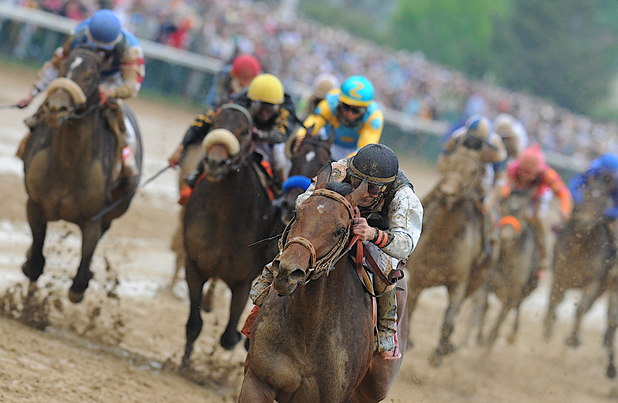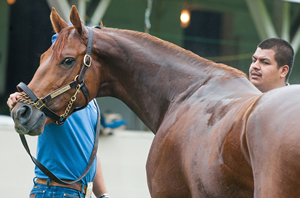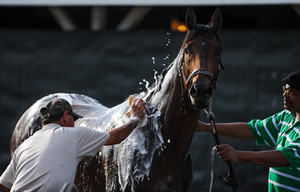Black Hole Horses (Sometimes Are Dark Stars)

Mine That Bird was a classic dark horse Derby winner in 2009. (Eclipse Sportswire)
You couldn’t find Done Talking on Monday morning. Oh, sure, he was on the grounds somewhere at Churchill Downs, but it was difficult to confirm his actual stall number or if even he was, indeed, alive and well.
Had he gone out that morning to train? Did he look good moving over the surface? No one seemed to know.
Camouflaged between two horses trained by Dale Romans, the Illinois Derby winner buried his head in his feed tub and didn’t look up when finally located after an equine treasure hunt.
He’s a black hole horse, a dark horse. He’s not supposed to attract attention.
When a giant star collapses in the universe, often a strange region of space-time is formed. The gravitational force of its nothingness is so powerful that it absorbs any light that hits its horizon; it doesn’t reflect — just stays “black.”
No discussion. No buzz. No radio talk. Nothing. Ignored.
Ask “Chip” Woolley to describe a black hole horse and he’ll give you three words — Mine That Bird, a nonentity who slipped quietly onto the Churchill Downs backside in 2009, galloped without fanfare, grazed every morning undisturbed, and knocked everyone’s socks off on Derby Day.
With 20 in the Derby field, it’s pretty much impossible for the national media to single out every one. Not all stars are collapsing into the void; some are shining brightly, and with a finite amount of space (and time), editorial choices must be made. So while Union Rags and Bodemeister and Dullahan and Hansen demand rapt attention, the others become glorified window dressing.
Sometimes, though, the window dressing wins.
Like Giacomo. Like Animal Kingdom. These things happen.
Want to read about “contender” Rousing Sermon? Not a workout report, but the story of the horse’s upbringing, his connections, the features we all enjoy in the weeks before Derby? Great. You’ll have to go all the way to Idaho for that.

Rousing Sermon at Churchill Downs. (Eclipse Sportswire)
Idaho Statesman columnist Brian Murphy has dutifully covered the horse, which was raised in the state by a businessman named Larry Williams, who lives in a town called Treasure Valley.
“Still, Rousing Sermon is expected to be one of the biggest long shots in the Kentucky Derby. He ranks 19th among 3-year-olds in graded-stakes earnings, the list used to determine which 20 horses gain entry to the first leg of the Triple Crown.
“Williams said his horse could be a ’40- or 50-to-1 long shot.”
Oh, wait, here’s some coverage from The Paulick Report, in this week’s Kentucky Derby Index. The black holes finally got ink: “The Horses No One Will Be Talking About trifecta box: Done Talking, Liaison, Rousing Sermon.”
Liaison? He’s the horse you’ve only heard of because Bob Baffert trains him, and Bob Baffert is so polarizing he could be training a mule and people would still stop by his barn and write up the story. Ask Baffert if he thinks Liaison, who hasn’t had a sniff of a winner’s circle since last December, is eclipsed by Arkansas Derby winner Bodemeister.
“Rightly so,” he’ll say.
And that’s about it.
Liaison isn’t the only one overshadowed by a more illustrious stablemate. Steve Asmussen’s Daddy Nose Best is a “wise guy” horse after winning the Sunland Derby, but you won’t hear much talk about Sabercat. Why would you? Third in the Arkansas Derby, eighth in the Rebel Stakes before that, no win since the Delta Jackpot all the way back in November.

Liaison at Churchill Downs. (Eclipse Sportswire)
This is not to say black hole horses don’t deserve to be in the race.
A horse can become a black hole by actually doing something positive: like arriving rather late to the party (attention UAE Derby victor Daddy Long Legs), winning what the experts consider to be the weakest Kentucky Derby prep with a slow Beyer speed figure (hello, Done Talking); or not so positive: running sixth in its last start (Prospective in the Blue Grass Stakes).
Some of them wobble on the edge of the precipice (Went the Day Well and El Padrino), kept barely in view by illustrious connections who won the Derby last time or because they were highly regarded before losing their sparkle and glow.
Yet did anyone interview Donerail’s connections in the days before the Derby of 1913? If they did, few read the papers. He was drawing away at the finish, set a new track record with a time of 2:04 4/5, and provided a $184.90 payoff for a $2 bet. Odds of 91-1, baby — longest shot in Derby history.
Charismatic (1999). Proud Clarion (1967). Dark Star (1953). Gallahadion (1940). Exterminator (1918). Stone Street (1908). Black hole horses. Someone believed in them, just not a lot of people knew it.
That’s the thing about these horses in the 20-horse Derby field. They may not figure as winners on paper, may not play the part in their gallops or pre-race breezes, but every once in a while, one of them jumps up and shocks us. When that happens, they go from one moment being a black hole, and in the next they are lighting up the tote board.
 A Chicago native, Claire Novak is the winner of the 2011 Media Eclipse Award for Feature/Commentary and has written on racing for some of the nation’s best-known outlets, including ESPN The Magazine and ESPN.com, the Associated Press, and NBC Sports. She is a former staff writer and current correspondent for The Blood-Horse Magazine, and is also a guest correspondent for Lady Luck on TVG.
A Chicago native, Claire Novak is the winner of the 2011 Media Eclipse Award for Feature/Commentary and has written on racing for some of the nation’s best-known outlets, including ESPN The Magazine and ESPN.com, the Associated Press, and NBC Sports. She is a former staff writer and current correspondent for The Blood-Horse Magazine, and is also a guest correspondent for Lady Luck on TVG. 

1 Comment